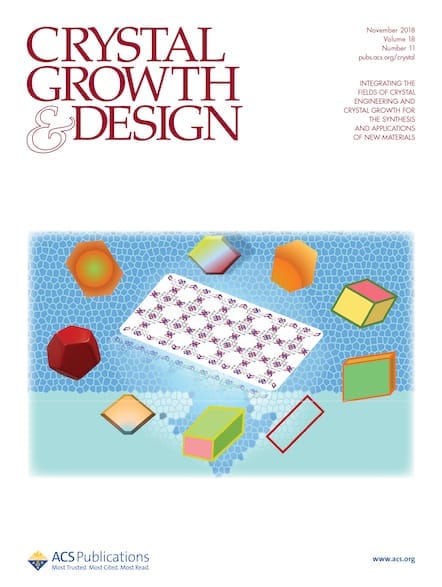Crystal Growth & Design (CG&D) Editor-in-Chief Robin Rogers and members of the journal’s editorial team highlight recent research published in CG&D, describing exciting findings in crystal growth, crystal engineering, and applications of crystalline materials. CG&D aims to facilitate innovation in every aspect of research and development in the crystalline state. Crystal Engineering External stimuli such […]

Crystal Engineering
External stimuli such as light, heat, and force can affect the molecular structure of single crystals. An understanding of these solid-state transformations is vital in crystal design and in the successful application of crystalline materials, for example as sensors or in optical devices.
“Purposeful design and control of the crystalline state of matter, promises to revolutionize technological applications of crystalline materials in a wide variety of fields from sensors and sorbents to pharmaceuticals.” – Robin Rogers, Editor-in-Chief
***
Recent Advances in Single-Crystal-to-Single-Crystal Transformation at the Discrete Molecular Level
“This review describes recent advances in Single-Crystal-to-Single-Crystal (SCSC) transformations, including those induced by heat, solvent, ion exchange, light, gas, and mechanochemical forces. SCSC has garnered significant interest over the past decade or so, because structural changes in such transformations can influence optical, magnetic, and other properties, and thus subsequent applications.” – Michael Zaworotko, Associate Editor
***
Engineering Crystal Properties through Solid Solutions
“For decades, solid solutions have taken a backseat when it comes to the development of organic functional materials, largely due to the difficulties affiliated with their design. Lusi and co-workers triggered a new surge in interest in these materials through a series of papers that have significantly contributed to our understanding of solid solutions. This informative and thought-provoking review now highlights the great potential of solid solutions in the context of materials design. I expect it to revive interest in solid solutions and to trigger new studies that will help us understanding them even better.” – Dejan-Krešimir Bučar, Topic Editor
Advances in Metal-Organic Frameworks
The design, synthesis, and characterization of unique metal-organic frameworks opens avenues of exploration into potential uses of these coordination polymers. MOFs can be utilized for the separation and storage of gases, ions, or organic molecules, advancing diverse applications such hydrogen-based energy and pharmaceutical drug development.
“The explosion of interest in this field in the last 15 years is directly traceable to the incredible technological impact these designer materials could have in key areas of societal importance, not the least of which is carbon capture for mediating climate change.” – Robin Rogers, Editor-in-Chief
***
Highly Fluorescent Metal–Organic Frameworks Based on a Benzene-Cored Tetraphenylethene Derivative with the Ability To Detect 2,4,6-Trinitrophenol in Water
“Highly fluorescent and water stable MOFs were shown to exhibit selective sensing abilities of nitro explosives. The MOFs are designed to be aggregation induced emission (AIE) active by the selective choice of the linker. These materials display remarkable fluorescence properties with high quantum yields.” – Kumar Biradha, Associate Editor
***
An Anionic Uranium-Based Metal–Organic Framework with Ultralarge Nanocages for Selective Dye Adsorption
“The authors sought to design an anionic MOF with large pores and pore windows for the adsorption of large dye molecules from water. They recognized that porosity-limiting interpenetration is topologically precluded in MOFs based on 3,4-connected tbo nets, and so chose to construct their MOF using the trigonal-planar UO2(COO)3– PBU in conjunction with a square, tetratopic ligand. The resulting anionic MOF has exceptionally large pore cages measuring more than 30 Å across, with a calculated void space of 85.5% of the structure’s volume. This publication is noteworthy because it helps to expand the relatively-understudied uranium-based MOF subfield in the direction of highly-porous MOFs, while simultaneously serving as an excellent example of the effectiveness of rational, topologically-directed MOF design.” – Jing Li, Associate Editor
Co-Crystal Benefits in Biomedicine
A drug’s crystal form can be critical to how well it works in the human body. Co-crystals – wherein an active pharmaceutical ingredient and another compound are crystallized together in order to optimize biopharmaceutical properties – are not yet common but they have been shown to provide some unique therapeutic benefits.
“The incredible outpouring of research and development investment in pharmaceutical co-crystals is directly tied to the promise of new designer drugs that can overcome the currently limited pipeline of new pharmaceuticals.” – Robin Rogers, Editor-in-Chief
***
Co-crystal of Tramadol Hydrochloride–Celecoxib (ctc): A Novel API–API Co-crystal for the Treatment of Pain
“Cocrystals, crystals comprising two or more solid compounds (coformers), are increasingly being utilized to optimize the biopharmaceutical properties of active pharmaceutical ingredients (APIs). Here, the authors report a cocrystal formed between two APIs that are painkillers, tramadol and celecoxib. The new solid form confers clinical advantages with respect to dissolution, drug release, and pharmacokinetics that cannot be achieved with a physical mixture of the two APIs.”– Michael Zaworotko, Associate Editor
***
Exploration of Solid Forms of Crisaborole: Crystal Engineering Identifies Polymorphism in Commercial Sources and Facilitates Cocrystal Formation
“Crystal Engineering brings out the sleuth in all of us!” – Robin Rogers, Editor-in-Chief
